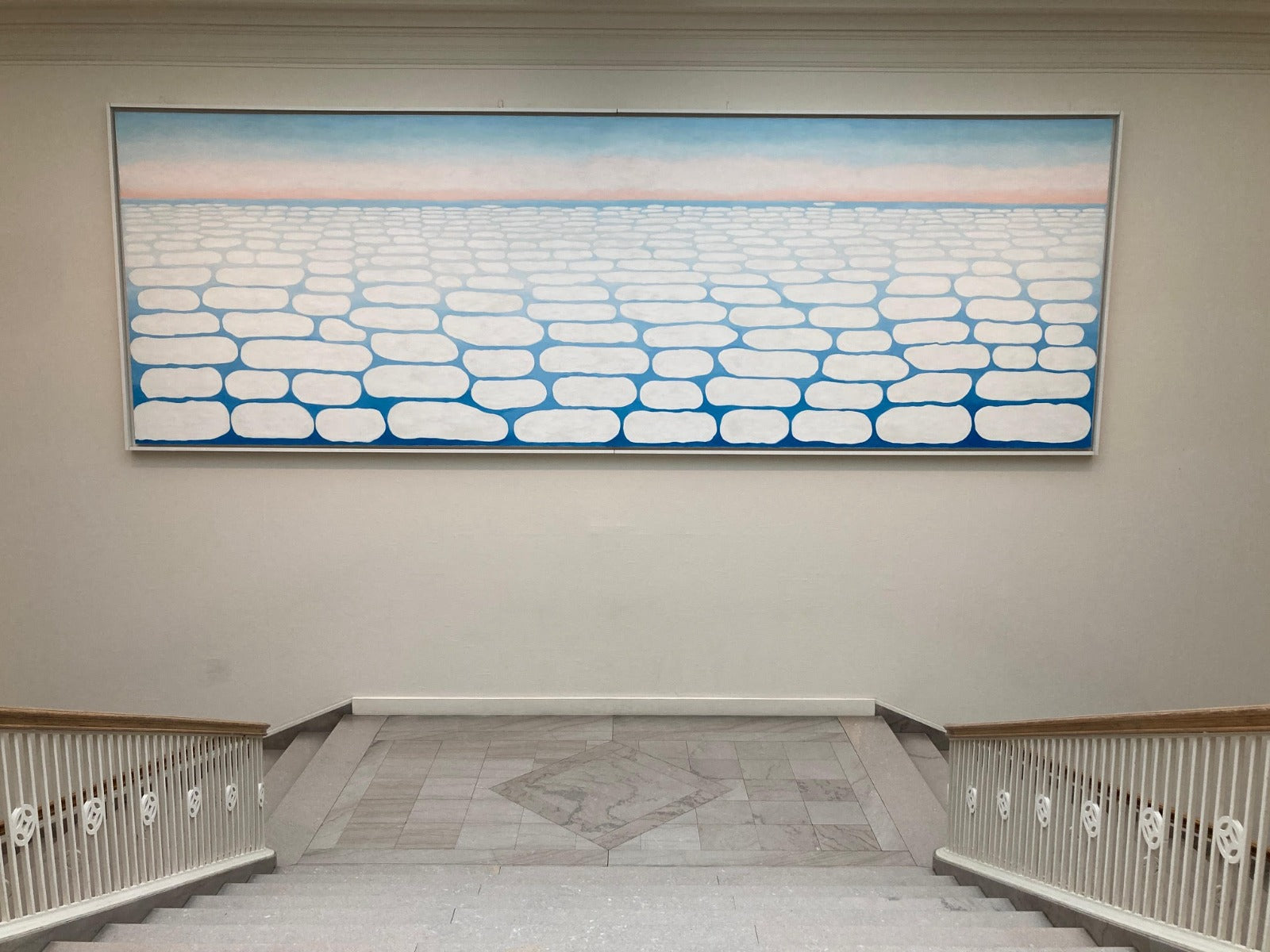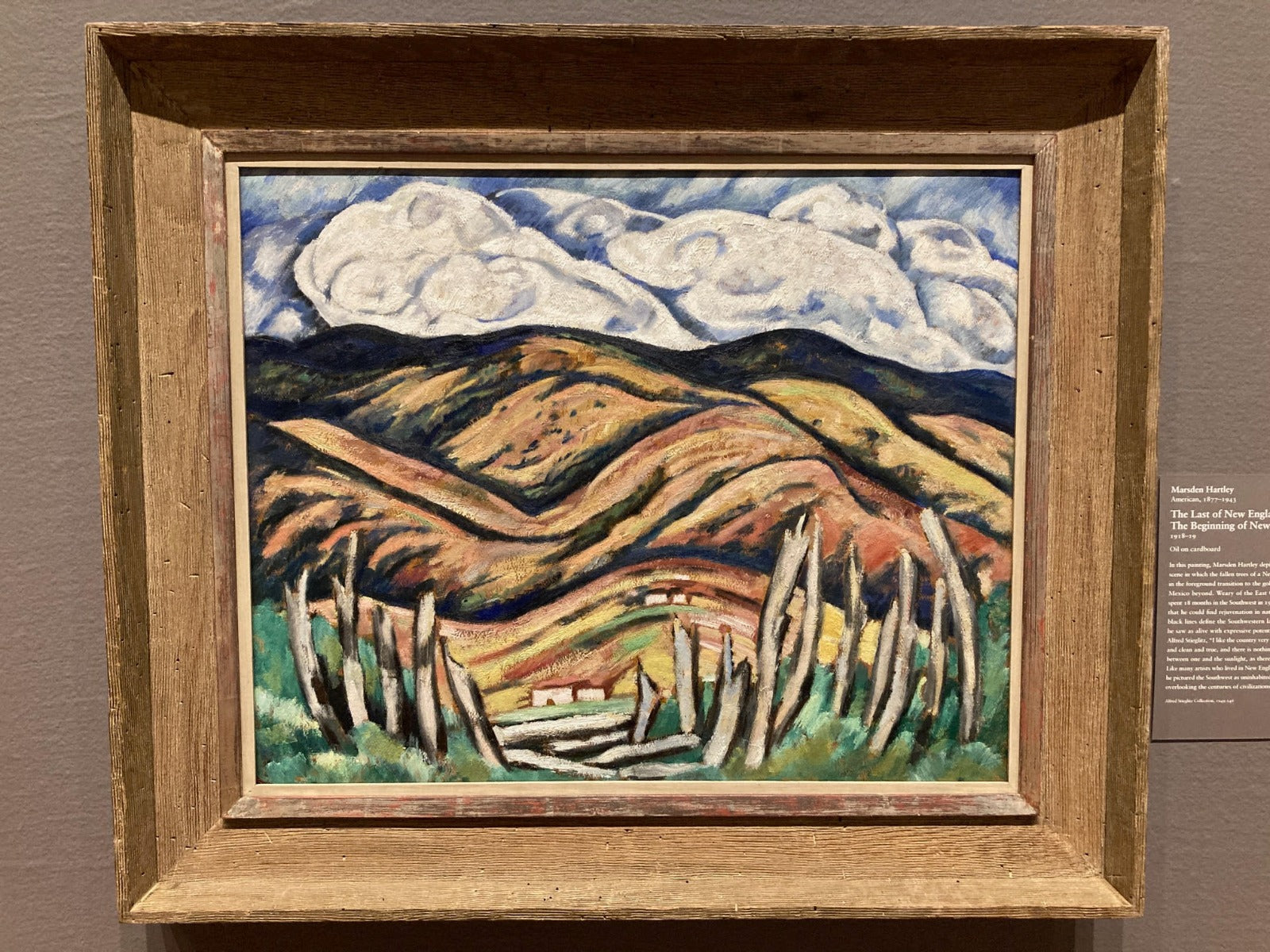Georgia O'Keeffe highlights Western artists at Art Institute of Chicago
By Medicine Man Gallery on

Georgia O'Keeffe, Sky Above Clouds IV (1965) at the Art Institute of Chicago | Photo by Chadd Scott
On any short list of the best art museums in the United States, you will find the Art Institute of Chicago. No museum in the world has more instantly recognizable paintings: Nighthawks, American Gothic, Monet’s haystacks, Van Gogh’s bedroom, A Sunday on La Grande Jatte.
The best of the best.
Only.
The museum divides its permanent collection galleries into roughly 20 broad categories – Arts of Africa, Arts of China, Japan and Korea, Arms and Armor, Prints and Drawings, Impressionism, and so on. I made my first visit to the museum in April of 2023, not primarily looking for Western art – Western United States, not Western Civilization – but intrigued by the museum’s treatment of the genre after spotting one or two pieces here and there.
The Art Institute of Chicago’s focus is global and historic. It is what’s referred to as an “encyclopedic museum,” meaning, like an encyclopedia – remember those – it attempts to house a diverse assortment of objects highlighting 5,000 years of human creativity from around the world.
The Art Institute does not distinguish its Western material from its broadly American items unlike, say, the Denver Art Museum which specifically segregates its Western art onto a “Western American Art” floor. That makes sense. It’s been a long time since Chicago identified as a “western” city.
Walking through the galleries, it dawned on me, here in one of the greatest art museums in the world, with no effort being made to feature specifically Western art, in a non-western part of the country, whatever Western art made it up on the walls surely must be the finest examples of their kind.
So, what made the cut?
Georgia O’Keeffe didn’t simply make the cut, she was in the starting five. Across the entire collection, you might consider the stars of the Art Institute Monet, Van Gogh, Renoir and O’Keeffe. No artists have more or more prominent representation there.
Georgia O’Keeffe: Western Artist
I will sidetrack here briefly.
Why isn’t O’Keeffe more broadly accepted by the Western art establishment as a Western artist? Surely, she was more than a Western artist – she was one of the all-time great painters, an all-time great Modernist, an all-time great American artist – but she was also, surely, a Western artist. Anyone who doesn’t think so or consider her as such should ask themselves why?
She lived in New Mexico for nearly 40 years. She visited on extended trips for 20 years prior to that. She loved the West, she advocated for the West, she painted the West. Among her most famous artworks are pictures of cow skulls, ram skulls, mountains and deserts. She didn’t take her inspiration for these paintings from Manhattan.
Yet, to read the Western art magazines or listen to experts on Western art talk, O’Keeffe rarely comes up. This boggles my mind.
For a marginal genre within the broader art world like Western American art, those of us who love it should be co-opting and forwarding O’Keeffe at every turn. And Agnes Martin. And Marsden Hartley. And Richard Diebenkorn. And Raymond Jonson. And Diego Rivera.
Welcoming them under the Big Top tent of Western art would raise the profile of the entire genre and all of the artists within it.
We do this with Bierstadt and Moran. They didn’t exclusively paint the West and neither spent anywhere near the amount of time as O’Keeffe did there, but both are firmly entrenched within the Western art genre. Why not O’Keeffe?
I fear the answer may have to do with her gender, anything traditionally “Western” being overly confused and diseased by patriarchy and machismo.

Georgia O'Keeffe, Black Cross, New Mexico (1929) | Photo by Chadd Scott
Georgia O’Keeffe at the Art Institute
For O’Keeffe, born and raised in nearby Wisconsin, enrolling at the School of the Art Institute in 1905, her presence at the Art Institute of Chicago begins with the monumental Sky Above Clouds IV (1965). And by monumental, I mean monumental: 8-feet high by 24-feet wide!
Painted when she was 77-years-old living in Abiquiu, New Mexico, the image portrays how she viewed the sky when traveling by plane. O’Keeffe was famous at this time, flying all over the country and world for events and exhibitions.
To me, this is a Western painting. Like O’Keeffe, not just a Western painting, but a Western painting also.
It’s vast, it’s landscape – or skyscape; it’s painted by a woman living and influenced by the West. Are these iconic clouds somehow less Western than Ed Mell’s or Tony Abeyta’s?
Ridiculous.
On my visit, the better part of an entire gallery in the “Arts of the America’s 1860-1950” section was devoted to O’Keeffe’s paintings and other artworks responding to O’Keeffe paintings. On display were bleached skulls and desert flowers and New Mexico landscapes – Western paintings.
Western Chicago
Representation of the West and western artists at the Art Institute of Chicago aside from O’Keeffe was scant, but noticeable to a keen eye. On view was a fantastic modern landscape painted in 1928 by Raymond Jonson, Inscription Rock. The scene comes from a sandstone headland now known as El Morro National Monument in New Mexico.
As mentioned previously, Jonson, and all of his Transcendental Painting Group colleagues, should be more fully embraced by the Western art genre. Just look at the work. It’s brilliant. It’s Western.
The prism of Western art should be broad, not narrow, to assure the genre’s continued relevance.
Hanging alongside the O’Keeffe’s was Marsden Hartley’s 1918-19 The Last of New England – the Beginning of New Mexico. Hartley was an easterner who spent 18 months in the Southwest during this time, but he “got” it, capturing the region like a native, a rare feat.
Two specifically Western art stalwarts had paintings on view in the Art Institute’s “Arts of the Americas, 1650-1910” section: Victor Higgins and Walter Ufer. Both pictures were representative of what they’re best known for.
Ufer’s The Solemn Pledge: Taos Indians (1916) portrays a tender, sun-splashed scene of Native American ceremony. Ufer trained at the School of the Art Institute of Chicago.
Higgins not only studied at the School of the Art Institute, he taught there. His first visit to Taos was sponsored by Chicagoans supporting local artists. Spring Rains (1924) depicts a bleached landscape with two Indigenous figures on horseback and a cow in the foreground around El Salto Peak in northern New Mexico. A cloud shadows the mountain as torrents of rain bring relief to the area.

Marsden Hartley, The Last of New England - The Beginning of New Mexico (1918-19) | Photo by Chadd Scott




